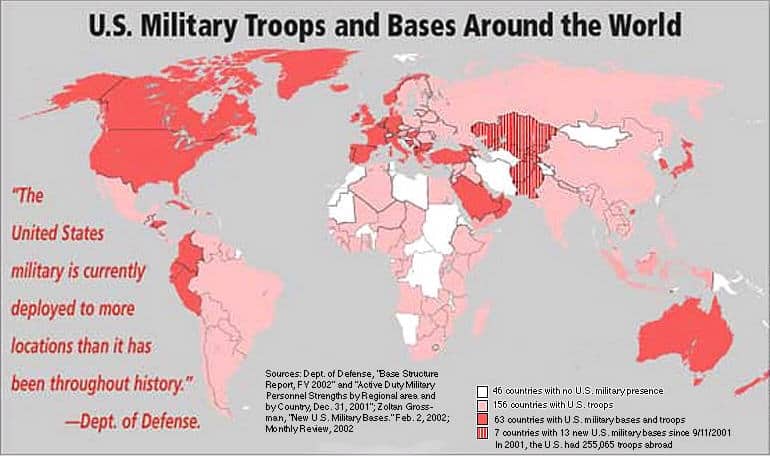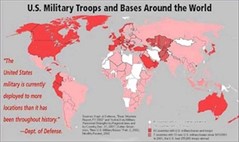It is difficult to pinpoint exactly when it happened, but clear evidence can be seen at least in the aftermath of World War II. Some trace the origins back to 1898 and the Spanish-American War, or even earlier to the War of 1812. And still others would say that imperial ambitions were even on the minds of some of the Founding Fathers. Regardless, there can be no doubt that today the United States of America is an empire.
It is probably safe to assume that most Americans do not think of their country as an empire. As a conservative in my younger years, I might have even labeled the suggestion as anti-American, rationalizing to myself: Sure, we may have strategic military bases around the world and we may use force at times, but it is only for benevolent purposes. We get the bad guys, give the country back to the good guys, and we leave. The US does not try to rule the world.
I was wrong.
While it has indeed expanded its borders through conquest in the past, the modern United States exercises its global hegemony in a different way than the old colonial empires: through a worldwide network of military bases. This network is so vast that there is probably not one single individual who knows precisely how many bases exist at any given time, but even the Pentagon acknowledges that the number is over 600, and with an honest assessment the total would surely be much higher than that, possibly over 1,000.
The fact is that America’s unique empire is the most expansive in all of history, covering 6 of 7 continents and nearly 150 countries, and including what are essentially 10 floating bases (or is it 19?) capable of establishing a military presence in any ocean on earth. There are currently about 160,000 US soldiers officially deployed overseas, along with many more tens of thousands or even hundreds of thousands of individuals such as spies, technicians and civilian contractors. This comes at an enormous cost, measurable in many different ways. Among these are the cost in blood, the price in dollars, and the impact on American society.
Blood
Just since WWII, the American Empire has sacrificed the lives of over 100,000 of its soldiers. The bulk of this number is accounted for in the Vietnam War and the Korean War, both undeclared and unnecessary wars. The remainder is mostly made up of deaths in the so-called War on Terror in both Afghanistan and Iraq – 6,822 to be exact, but the War on Terror is perpetual by its own definition and by design, so this number is most certainly not final. On top of this number – which is already more than double the deaths on 9/11 – are many tens of thousands wounded.
The battlefield is not the only place where the blood of soldiers is spilled. A shocking twenty-two US veterans commit suicide every single day, with nearly one active duty soldier suicide per day. This means that there are currently more soldiers taking their own lives than being killed on the battlefield. The common diagnosis of this epidemic is the inadequate treatment of posttraumatic stress disorder (PTSD). However, as the Future of Freedom Foundation’s Jacob Hornberger suggests, the root cause may be more accurately identified as “guilt –massive unresolved guilt over the wrongful killing of other human beings” in unjust wars like Iraq.
The cost in the blood of innocent civilians has been astronomically higher than that of soldiers – well into the millions. The Vietnam War alone saw the deaths of two million civilians. Throughout the 1990s and following the first war on Iraq by the first president Bush, the US caused the deaths of as many as half a million children with its crippling sanctions aimed at punishing former US ally Saddam Hussein, a price that the Clinton administration said was “worth it” (not just once, but twice).
In 2003, the second president Bush again invaded Iraq, and for reasons that were demonstrated to be lies. There were over 133,000 individually recorded civilian deaths due to direct violence, but this number is known to be very low. It is estimated that the total count of Iraqi deaths, both civilians and fighters, due to the US invasion could be over 650,000 and possibly even over a million. Over 11 years later, people continue to die daily as a result of the violence that consumes the country. In addition, between 1.5 and 4.5 million people have been displaced from their homes, surely never to return. Further, post-war Iraq has been plagued with a dramatic increase in cancer and birth defects – likely the result of the US military’s use of depleted uranium and white phosphorus.
In Afghanistan, the number of children dying from unexploded ordnance left behind by the US military is rising. American forces have removed munitions from only 3 percent of the “800 square miles of land littered with undetonated grenades, rockets and mortar shells”. Although military officials say they intend to clean up the munitions left behind, other former US warzones remain deadly to this day, including Vietnam where bombs continue to kill civilians over 40 years after the last American soldier left the country.
The latest trend of US Empire-imposed death on foreigners (as well as four American citizens) is through drone strikes. President Obama has heavily increased the use of drones throughout the world, and there has been much evidence showing a high rate of civilian deaths. In an effort to distort the numbers of civilian drone victims, Obama has redefined the word “militant” to mean any military-aged male killed within a blast radius. In other words, he has redefined “civilian” to not include any male above the age of 18 regardless of whether he is actually a civilian. The Obama administration has even routinely and intentionally targeted first responders to the scene of drone attacks in “double tap” strikes (which the US considers “terrorism” if done by others), in addition to striking multiple wedding parties in what it claims were mistakes.
Treasure
The official budget for the Department of Defense is about $500 billion. However, this does not give an accurate picture of what the US actually spends on militarism. The official figures exclude significant expenditures that are spread throughout the Federal government. For 2015, this includes $157 billion in veterans’ benefits and $83 billion in non-veteran military benefits, $19 billion to maintain the US nuclear arsenal (categorized under the Department of Energy), and $41 billion for the Department of Homeland Security. The official numbers also exclude the interest on the national debt from past military spending, which is conservatively estimated to be over $185 billion annually, and some estimate to be up to $364 billion for fiscal year 2015. When taking into account these and other non-Department of Defense expenditures, the annual cost of the Empire easily tops $1 trillion.
To understand how expensive the US Empire’s wars are, consider the recent War on Iraq. The cost to date is over $1.7 trillion with an additional $490 billion in veteran benefits that must be paid. That price tag is jaw dropping as it is, particularly in light of the Bush administrations absurdly low predictions in the $50 billion to $60 billion range. But the true costs when accounting for interest over the next four decades could be a staggering $6 trillion.
In addition to the direct costs, there is enormous opportunity cost as a result of the massive government expenditure on militarism. This cost is incalculable, since it is impossible to know the productive uses to which capital may have been put had it not been squandered by the government and diverted to destructive purposes. But it is reasonable to expect that regardless of where the money went, it would have been more productive than building weapons to blow up people and property in aggressive wars of choice.
Soul
Perhaps the most insidious effect of imperialism is that which it has on the society that lives under it. The family is subordinated to the State as soldiers leave their loved ones behind to go fight in wars ostensibly to defend freedom and keep Americans safe, but which in reality have little to do with these reasons and are instead primarily about fighting for the interests of the Empire. Fathers, mothers, husbands, wives, sons and daughters are killed, maimed and psychologically scarred for life. Thousands of orphans and widows are created, and the impact is felt throughout generations.
Sporting events and other recreational activities prominently feature the military and have become celebrations of war, many of them complete with soldiers in uniform marching with guns and fighter jets flying overhead. Many Americans have been convinced that it is necessary for the US to maintain a prison camp in Cuba (of all places!) where inmates are held indefinitely without trial in abhorrent conditions and even in spite of many having long been cleared for release. Actions that would have been abominable to most people in any other circumstance – such as torture – are gradually accepted. Even many churches are overcome with nationalism and abandon their religious teachings of peace. “Support the troops” becomes the highest virtue, supplanting The Golden Rule and “blessed are the peacemakers”.
Constant imperial aggression seems to have a conditioning effect on a society. People who live under empire grow to accept similar treatment as those on the receiving end of their government’s foreign violence. Mark Twain identified this phenomenon when he predicted in 1909 the eventual results of imperialism following the US conquest of the Philippines:
Lust of conquest had long ago done its work; trampling upon the helpless abroad had taught her, by a natural process, to endure with apathy the like at home; multitudes who had applauded the crushing of other people’s liberties, lived to suffer for their mistake in their own persons.
This sentiment is put even more succinctly by the inimitable Scott Horton who paraphrases the late American author and professor Chalmers Johnson by saying: “You either give up your empire or you live under it.”
Evidence of the truth of these statements can been seen in the way Americans are treated domestically by government forces. The US has the largest prison population in the world, with half of inmates imprisoned for drug offenses. There are over 100 SWAT team raids per day in this country, many of them no-knock raids conducted in the middle of the night with disastrous consequences to totally innocent victims.
In post-9/11 America, it has become commonly accepted that one must submit to either a full body scan or an intrusive pat down at the hands of a government employee before boarding an airplane. Americans live under the largest surveillance apparatus in world history. The NSA collects billions of phone calls, emails and cell phone location records every month without a warrant or even probable cause. The notion of being secure in one’s person and property from government intrusion is virtually a thing of the past.
Ultimately, the justifications given for a global US military presence are false. As a result of the Empire, Americans are less free, and they are also less safe due to the hatred that their government’s actions throughout the world engender. Americans are immeasurably poorer as a result of massive government spending and debt. And as subjects of the US Empire, many Americans sacrifice a part of their humanity and even begin to view people outside of their country the same way their government does, and are gradually finding themselves treated similarly at home as well. The price of the Empire – in blood, treasure and soul – is simply too high to tolerate.


